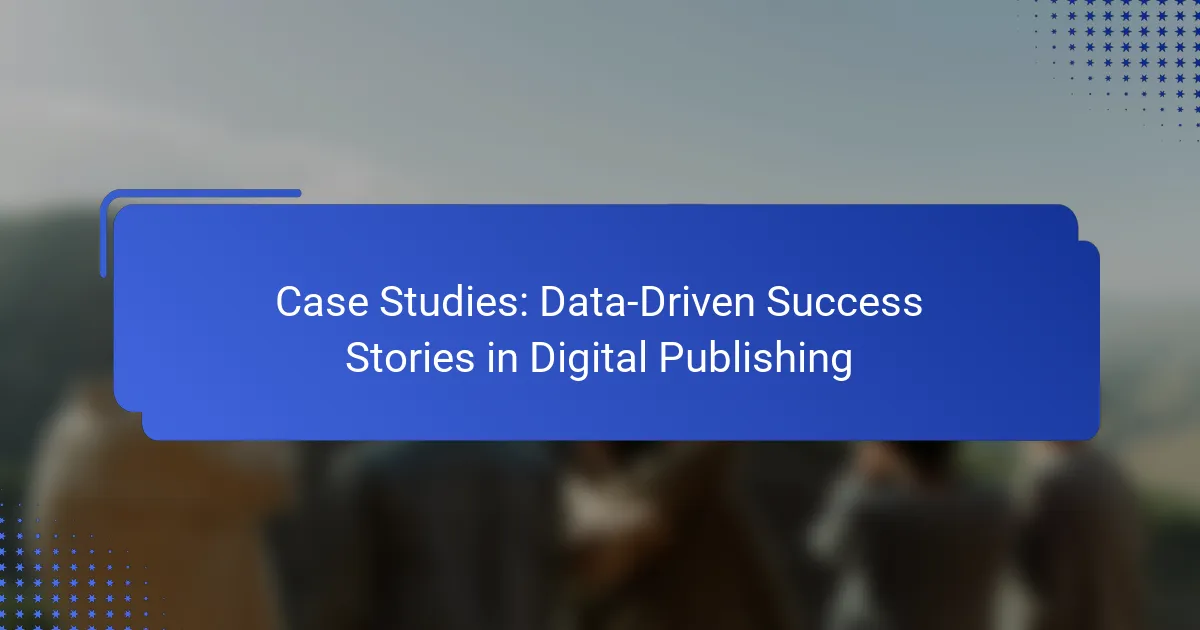In the rapidly evolving landscape of digital publishing, successful case studies highlight the power of data-driven strategies in enhancing audience engagement and driving revenue. By leveraging analytics, organizations can gain valuable insights into reader behavior and preferences, enabling them to optimize content delivery and improve overall satisfaction. These examples demonstrate how innovative approaches and the right tools can lead to measurable success in the industry.

What are successful case studies in digital publishing?
Successful case studies in digital publishing showcase how organizations leverage data to enhance their strategies, improve audience engagement, and drive revenue. These examples illustrate practical applications of analytics and innovative approaches that lead to measurable outcomes in the industry.
Case Study: The Guardian’s Data-Driven Strategy
The Guardian has effectively utilized data analytics to refine its content strategy and optimize user experience. By analyzing reader behavior and preferences, the publication tailors its articles and headlines to increase engagement, resulting in higher click-through rates and longer time spent on site.
One key aspect of their strategy is the use of A/B testing for headlines and layouts, allowing them to determine which variations resonate best with their audience. This iterative approach has helped The Guardian maintain relevance and adaptability in a competitive digital landscape.
Case Study: BuzzFeed’s Audience Engagement
BuzzFeed excels in audience engagement through its data-driven content creation. By leveraging social media analytics and user feedback, BuzzFeed identifies trending topics and formats that captivate its audience, leading to viral content and increased shares.
The platform employs a combination of quizzes, listicles, and interactive content that encourages user participation. This strategy not only boosts engagement but also enhances brand loyalty, as readers feel more connected to the content they help create.
Case Study: The New York Times Subscription Model
The New York Times has successfully implemented a subscription model that relies heavily on data insights to attract and retain subscribers. By analyzing user behavior, the publication tailors its offerings, such as personalized newsletters and exclusive content, to meet the needs of different audience segments.
Additionally, the Times uses predictive analytics to identify potential subscribers and optimize its marketing strategies. This data-driven approach has resulted in significant growth in subscription numbers, demonstrating the effectiveness of personalized engagement in driving revenue.

How did data analytics improve digital publishing?
Data analytics significantly enhances digital publishing by providing insights into audience behavior, preferences, and engagement patterns. This information allows publishers to make informed decisions that optimize content delivery and improve overall reader satisfaction.
Enhanced Audience Targeting
Data analytics enables publishers to identify specific audience segments based on demographics, interests, and online behavior. By utilizing tools like Google Analytics or social media insights, publishers can tailor their marketing strategies to reach the most relevant readers effectively.
For instance, a publisher might discover that a particular article resonates more with younger audiences. They can then allocate more resources to promote similar content through channels frequented by that demographic, increasing engagement and conversion rates.
Content Personalization Techniques
Personalization techniques driven by data analytics allow publishers to deliver customized content experiences to their readers. By analyzing user interactions, publishers can recommend articles, products, or services that align with individual preferences.
For example, using algorithms to track reading habits, a digital magazine can suggest articles based on previously read topics. This not only enhances user experience but also encourages longer site visits and higher retention rates.

What tools are used for data-driven publishing?
Data-driven publishing relies on various tools that help analyze audience behavior, visualize data, and automate marketing efforts. These tools enable publishers to make informed decisions based on actionable insights, improving content strategy and audience engagement.
Google Analytics for Audience Insights
Google Analytics is essential for understanding audience behavior on digital platforms. It tracks user interactions, providing insights into demographics, interests, and engagement metrics, which can guide content creation and marketing strategies.
To effectively use Google Analytics, set up goals to measure conversions and utilize segmentation to analyze specific audience groups. Regularly review reports on user acquisition and behavior to identify trends and optimize content accordingly.
Tableau for Data Visualization
Tableau is a powerful tool for visualizing complex data sets, making it easier to interpret and share insights. It allows publishers to create interactive dashboards that highlight key performance indicators and trends in a visually appealing manner.
When using Tableau, focus on creating clear, concise visualizations that tell a story with your data. Consider using filters and parameters to allow stakeholders to explore data dynamically, enhancing their understanding of audience engagement and content performance.
HubSpot for Marketing Automation
HubSpot streamlines marketing efforts through automation, helping publishers manage campaigns and track performance. It integrates various marketing tools, including email marketing, social media management, and lead generation, all in one platform.
To maximize HubSpot’s effectiveness, segment your audience for targeted campaigns and utilize A/B testing to refine messaging. Regularly analyze performance metrics to adjust strategies and improve engagement rates, ensuring your content reaches the right audience effectively.

What are the key metrics for measuring success?
Key metrics for measuring success in digital publishing include engagement rates, conversion rates, and subscriber growth. These metrics provide insights into audience interaction, effectiveness of content, and overall business health.
Engagement Rates
Engagement rates reflect how actively users interact with your content. This includes metrics such as time spent on page, comments, shares, and likes. High engagement rates indicate that your audience finds the content valuable and relevant.
To improve engagement, focus on creating high-quality, targeted content that resonates with your audience. Consider using interactive elements like polls or quizzes to boost participation. Aim for engagement rates in the range of 5% to 15% for optimal performance.
Conversion Rates
Conversion rates measure the percentage of users who complete a desired action, such as signing up for a newsletter or making a purchase. This metric is crucial for assessing the effectiveness of your calls to action and overall user experience.
To enhance conversion rates, ensure that your landing pages are optimized for clarity and ease of use. A typical conversion rate for digital publishing can range from 1% to 5%, depending on the industry and the specific goals of your campaign.
Subscriber Growth
Subscriber growth indicates how effectively you are attracting and retaining your audience. This metric is vital for building a loyal reader base and generating revenue through subscriptions or advertising.
To foster subscriber growth, implement strategies such as offering exclusive content, utilizing social media promotions, and optimizing your sign-up process. Aim for a steady growth rate of 10% to 20% annually to maintain momentum in your subscriber base.

What challenges do publishers face with data?
Publishers encounter several challenges with data, including compliance with privacy regulations, integration of diverse data sources, and ensuring data accuracy. These obstacles can hinder their ability to leverage data effectively for decision-making and audience engagement.
Data Privacy Regulations
Data privacy regulations, such as the General Data Protection Regulation (GDPR) in Europe and the California Consumer Privacy Act (CCPA) in the United States, impose strict guidelines on how publishers collect, store, and use personal data. Compliance with these laws is critical, as violations can lead to hefty fines and damage to reputation.
To navigate these regulations, publishers should implement clear consent mechanisms, maintain transparency with users about data usage, and regularly audit their data practices. Staying informed about changes in legislation is essential to avoid potential pitfalls.
Data Integration Issues
Data integration issues arise when publishers attempt to consolidate data from various sources, such as website analytics, social media platforms, and customer relationship management systems. Disparate data formats and systems can complicate this process, leading to incomplete or inaccurate insights.
To address integration challenges, publishers should consider using data management platforms that facilitate seamless data aggregation. Establishing standardized data formats and protocols can also enhance compatibility and streamline analysis, enabling better decision-making.

How can publishers leverage emerging trends?
Publishers can leverage emerging trends by adopting innovative technologies that enhance content creation, distribution, and monetization. By integrating tools like AI and blockchain, they can improve efficiency, transparency, and audience engagement.
Utilizing AI for Content Creation
AI can significantly streamline content creation by automating tasks such as writing, editing, and data analysis. Tools like natural language processing (NLP) enable publishers to generate articles quickly, analyze reader preferences, and personalize content for specific audiences.
For example, AI-driven platforms can produce news summaries or assist in generating social media posts, allowing publishers to focus on more complex storytelling. However, it’s essential to maintain a balance between automation and human creativity to ensure quality and authenticity.
Adopting Blockchain for Transparency
Blockchain technology offers publishers a way to enhance transparency in content distribution and monetization. By using decentralized ledgers, publishers can track the ownership and usage rights of digital content, ensuring fair compensation for creators.
Implementing blockchain can also reduce fraud in advertising by providing verifiable data on ad placements and interactions. Publishers should consider the initial setup costs and the need for technical expertise when adopting this technology, but the long-term benefits of trust and accountability can be substantial.

What is the future of data-driven publishing?
The future of data-driven publishing is centered on leveraging analytics to enhance content creation, distribution, and audience engagement. As technology evolves, publishers will increasingly rely on data insights to make informed decisions, optimize their strategies, and drive revenue growth.
Emerging technologies in data-driven publishing
Emerging technologies such as artificial intelligence (AI), machine learning, and big data analytics are transforming the landscape of data-driven publishing. These tools enable publishers to analyze vast amounts of data quickly, uncovering trends and audience preferences that inform content strategy.
For example, AI can assist in personalizing content recommendations for readers, while machine learning algorithms can predict which topics will resonate most with specific demographics. This technology not only enhances user experience but also increases engagement and retention rates.
Key metrics for success
To measure the success of data-driven publishing, key performance indicators (KPIs) should be established. Common metrics include audience growth, engagement rates, conversion rates, and revenue per user. Tracking these metrics allows publishers to assess the effectiveness of their strategies and make necessary adjustments.
For instance, a publisher might find that articles optimized for mobile devices have higher engagement rates, prompting a shift in content format. Regularly reviewing these metrics ensures that the publishing strategy remains aligned with audience needs and market trends.
Challenges and considerations
While data-driven publishing offers numerous benefits, it also presents challenges. Data privacy regulations, such as the General Data Protection Regulation (GDPR) in Europe, require publishers to handle user data responsibly and transparently. Non-compliance can lead to significant fines and damage to reputation.
Additionally, the sheer volume of data can be overwhelming. Publishers should focus on collecting relevant data that directly informs their goals rather than attempting to analyze everything. Prioritizing actionable insights over sheer quantity can lead to more effective decision-making.
Best practices for implementation
Implementing a data-driven approach requires a clear strategy. Start by defining specific goals and identifying the data needed to achieve them. Invest in the right tools and technologies that facilitate data collection and analysis.
Regular training for staff on data literacy is essential to ensure that everyone understands how to interpret and utilize data effectively. Finally, foster a culture of experimentation where data-driven insights can lead to innovative content strategies and business models.
